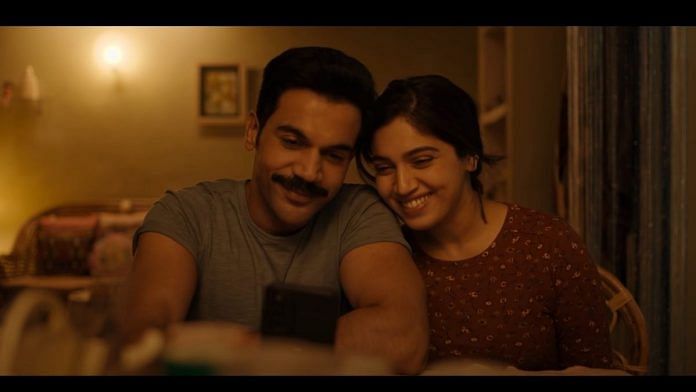I could write two reviews for Badhaai Do on the basis of whether or not I recognise my privilege. On one hand, I can be upset that Bollywood still needs to be braver in its depiction of queer love and the issue surrounding ‘not straight’ identities. On the other, I can remember how it feels like to be living in a small town and hide even heterosexual, consensual love, not just from your family, but neighbours, the mohalla and everyone else who might ‘inform’ your parents as part of their ‘civic duty’.
In a sentence, the film gets everything right except for the ‘lavender marriage’, which refers to the marriage of convenience to conceal the socially-stigmatised sexual orientation of one or both partners. The film is brave, but it does not wish to come out. Also, any resemblance to its partial namesake Badhaai Ho (2018) ends there.
The humour trope
Somewhere along the line, Bollywood discovered the trope of humour to treat ‘serious subjects’, especially when it comes to the representation of queer love in the mainstream, commercial films. From Shubh Mangal Savdhaan (2017) to its sequel, Shubh Mangal Zyada Saavdhan (2020) to now Badhaai Do, the trope has been consistent.
In 2022, we cannot hide behind humour and handle the audience with kid gloves. And it is not enough to show a glimpse of a pride walk to show ‘aal izz well’. It is not. Violence and trauma are a big part of accepting one’s queerness, and sometimes even coming out to families. In the film, the parents are mollified pretty easily, despite being from the dominant caste, Hindu Thakur families from Uttar Pradesh. The triumph of acceptance, by now, is too fantastical to have a real appeal.
Badhaai Do leaves you with an ache because the humour stings more than eliciting laughs — a feat achieved mostly by its smart dialogues. The film had a script consultant from the queer community, and it shows. Be it a character saying that being a lesbian “humare life ka hissa hai, puri life thodi na hai” to “jis sex mein bacha ho jaye, use sex nahi kehte, dayitva kehte hai”. Full points to the dialogues.
Also Read: Where are India’s queer parents? Having a family is not even an option for many Indians
‘Token’ actors, ‘brave’ subject
Rajkummar Rao and Bhumi Pednekar play the lead in the film. Both are, in a way, tokens for ‘hatke’ subjects in Bollywood. In fact, for Rao, this is the third film about queer love, after Aligarh (2015) and Ek Ladki Ko Dekha Toh Aisa Laga. The latter, released in 2019, was a much braver attempt from a much smaller town, Monga, as opposed to Badhai Do, set in Dehradun.
I remember watching Ek Ladki Ko Dekha Toh Aisa Laga with a queer friend, who was watching it for the second time. She said, ‘every bit of representation in Bollywood matters.’ That is true of Badhaai Do as well. The visibility is nuanced, be it through Rimjhim’s character who hails from Arunachal Pradesh, or the idea that even gay men can be male chauvinistic pigs, unlike the largely popular notion that they are sensitive and woke-er than cishet men. But ultimately, we still wait for certain heterosexual actors to play ‘uncomfortable’ roles. We seem to be eras away from hiring queer actors. In fact, on many occasions, artists have called out Bollywood’s inability to find queer ‘talent’.
View this post on Instagram
Badhaai Do does give you a glimpse of what it means to be queer when the tongue finds the word to be unfamiliar because of upbringing and limited exposure. It also looks at the heartbreaks you cannot discuss with anyone, because everything about you is hidden, especially your sexuality, in your ‘normal’, make-believe life.
Despite making you feel a range of emotions, the film ultimately just about toes the line. It does not push boundaries and is content in being a ‘lavender marriage’ itself, satisfying both the largely heterosexual audience and even those who might oppose the ‘taboo’ topic of queer love.
(Edited by Srinjoy Dey)






